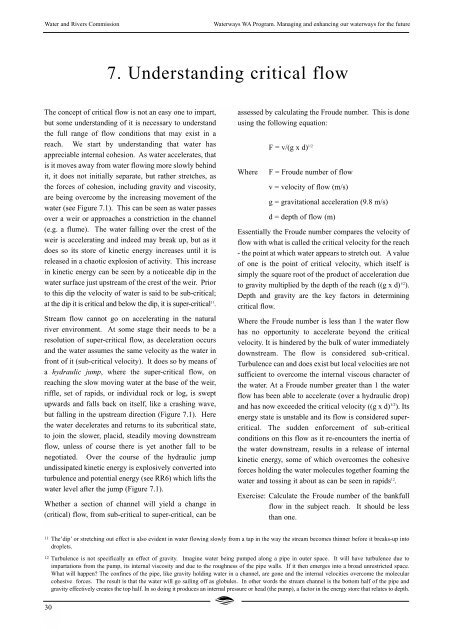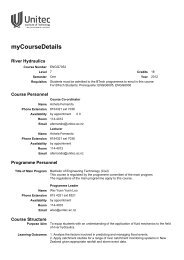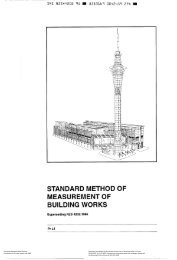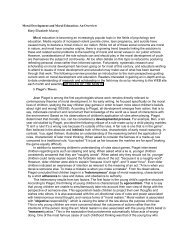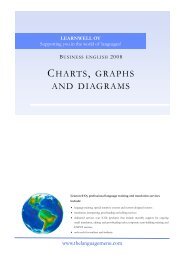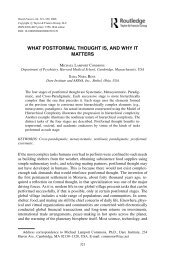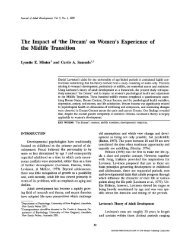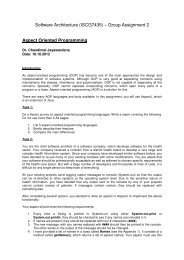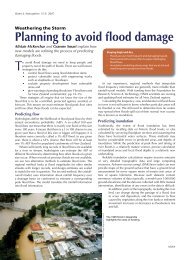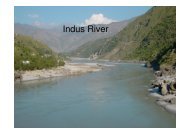7. Understanding critical flow
7. Understanding critical flow
7. Understanding critical flow
Create successful ePaper yourself
Turn your PDF publications into a flip-book with our unique Google optimized e-Paper software.
Water and Rivers Commission<br />
Waterways WA Program. Managing and enhancing our waterways for the future<br />
<strong>7.</strong> <strong>Understanding</strong> <strong>critical</strong> <strong>flow</strong><br />
The concept of <strong>critical</strong> <strong>flow</strong> is not an easy one to impart,<br />
but some understanding of it is necessary to understand<br />
the full range of <strong>flow</strong> conditions that may exist in a<br />
reach. We start by understanding that water has<br />
appreciable internal cohesion. As water accelerates, that<br />
is it moves away from water <strong>flow</strong>ing more slowly behind<br />
it, it does not initially separate, but rather stretches, as<br />
the forces of cohesion, including gravity and viscosity,<br />
are being overcome by the increasing movement of the<br />
water (see Figure <strong>7.</strong>1). This can be seen as water passes<br />
over a weir or approaches a constriction in the channel<br />
(e.g. a flume). The water falling over the crest of the<br />
weir is accelerating and indeed may break up, but as it<br />
does so its store of kinetic energy increases until it is<br />
released in a chaotic explosion of activity. This increase<br />
in kinetic energy can be seen by a noticeable dip in the<br />
water surface just upstream of the crest of the weir. Prior<br />
to this dip the velocity of water is said to be sub-<strong>critical</strong>;<br />
at the dip it is <strong>critical</strong> and below the dip, it is super-<strong>critical</strong> 11 .<br />
Stream <strong>flow</strong> cannot go on accelerating in the natural<br />
river environment. At some stage their needs to be a<br />
resolution of super-<strong>critical</strong> <strong>flow</strong>, as deceleration occurs<br />
and the water assumes the same velocity as the water in<br />
front of it (sub-<strong>critical</strong> velocity). It does so by means of<br />
a hydraulic jump, where the super-<strong>critical</strong> <strong>flow</strong>, on<br />
reaching the slow moving water at the base of the weir,<br />
riffle, set of rapids, or individual rock or log, is swept<br />
upwards and falls back on itself, like a crashing wave,<br />
but falling in the upstream direction (Figure <strong>7.</strong>1). Here<br />
the water decelerates and returns to its sub<strong>critical</strong> state,<br />
to join the slower, placid, steadily moving downstream<br />
<strong>flow</strong>, unless of course there is yet another fall to be<br />
negotiated. Over the course of the hydraulic jump<br />
undissipated kinetic energy is explosively converted into<br />
turbulence and potential energy (see RR6) which lifts the<br />
water level after the jump (Figure <strong>7.</strong>1).<br />
Whether a section of channel will yield a change in<br />
(<strong>critical</strong>) <strong>flow</strong>, from sub-<strong>critical</strong> to super-<strong>critical</strong>, can be<br />
assessed by calculating the Froude number. This is done<br />
using the following equation:<br />
Where<br />
F = v/(g x d) 1/2<br />
F = Froude number of <strong>flow</strong><br />
v = velocity of <strong>flow</strong> (m/s)<br />
g = gravitational acceleration (9.8 m/s)<br />
d = depth of <strong>flow</strong> (m)<br />
Essentially the Froude number compares the velocity of<br />
<strong>flow</strong> with what is called the <strong>critical</strong> velocity for the reach<br />
- the point at which water appears to stretch out. A value<br />
of one is the point of <strong>critical</strong> velocity, which itself is<br />
simply the square root of the product of acceleration due<br />
to gravity multiplied by the depth of the reach ((g x d) 1/2 ).<br />
Depth and gravity are the key factors in determining<br />
<strong>critical</strong> <strong>flow</strong>.<br />
Where the Froude number is less than 1 the water <strong>flow</strong><br />
has no opportunity to accelerate beyond the <strong>critical</strong><br />
velocity. It is hindered by the bulk of water immediately<br />
downstream. The <strong>flow</strong> is considered sub-<strong>critical</strong>.<br />
Turbulence can and does exist but local velocities are not<br />
sufficient to overcome the internal viscous character of<br />
the water. At a Froude number greater than 1 the water<br />
<strong>flow</strong> has been able to accelerate (over a hydraulic drop)<br />
and has now exceeded the <strong>critical</strong> velocity ((g x d) 1/2 ). Its<br />
energy state is unstable and its <strong>flow</strong> is considered super<strong>critical</strong>.<br />
The sudden enforcement of sub-<strong>critical</strong><br />
conditions on this <strong>flow</strong> as it re-encounters the inertia of<br />
the water downstream, results in a release of internal<br />
kinetic energy, some of which overcomes the cohesive<br />
forces holding the water molecules together foaming the<br />
water and tossing it about as can be seen in rapids 12 .<br />
Exercise: Calculate the Froude number of the bankfull<br />
<strong>flow</strong> in the subject reach. It should be less<br />
than one.<br />
11 The’dip’ or stretching out effect is also evident in water <strong>flow</strong>ing slowly from a tap in the way the stream becomes thinner before it breaks-up into<br />
droplets.<br />
12 Turbulence is not specifically an effect of gravity. Imagine water being pumped along a pipe in outer space. It will have turbulence due to<br />
impartations from the pump, its internal viscosity and due to the roughness of the pipe walls. If it then emerges into a broad unrestricted space.<br />
What will happen? The confines of the pipe, like gravity holding water in a channel, are gone and the internal velocities overcome the molecular<br />
cohesive forces. The result is that the water will go sailing off as globules. In other words the stream channel is the bottom half of the pipe and<br />
gravity effectively creates the top half. In so doing it produces an internal pressure or head (the pump), a factor in the energy store that relates to depth.<br />
30
Water and Rivers Commission<br />
Waterways WA Program. Managing and enhancing our waterways for the future<br />
The significance of super <strong>critical</strong> <strong>flow</strong><br />
Super <strong>critical</strong> <strong>flow</strong> conditions have both ecological and<br />
hydrological implications of great significance to stream<br />
management.<br />
For the stream ecosystem the hydraulic jump is a very<br />
significant component. Firstly it entrains air into the<br />
water column, oxygenating the stream ecosystem.<br />
Secondly, it provides a ‘launch pad’ for fish seeking to<br />
leap obstructions in their efforts to move upstream. For<br />
jumps that have a chute form, water may also swirl<br />
upstream either side of the fall of water, again assisting<br />
aquatic organisms to move upstream. Thirdly, the<br />
hydraulic jump is the only time that the pure movement<br />
of water makes sound (the babbling of brooks and the<br />
roaring of rapids), through the bursting of bubbles, as the<br />
entrained air rises to the surface. And fourthly, the<br />
super-<strong>critical</strong> <strong>flow</strong> conditions are primary habitat for<br />
certain aquatic organisms.<br />
For modified or human-made channels super<strong>critical</strong><br />
<strong>flow</strong> has advantages and disadvantages. It is not<br />
uncommon for engineers to create channels with<br />
sufficient depth, smoothness and slope to create super<br />
<strong>critical</strong> <strong>flow</strong>; in order to move water faster through a<br />
small narrow channel, and thus free-up land for<br />
development or reduce the amount of land that needs to<br />
be purchased. Such channels however are inherently<br />
dangerous and must be fenced-off. They must also be<br />
made of concrete or stone to prevent erosion from the<br />
powerful <strong>flow</strong>s.<br />
Super <strong>critical</strong> <strong>flow</strong>, with its high velocity and turbulent<br />
motion, often with standing waves and occurring on a<br />
slippery surface, presents a considerable hazard to<br />
people and other terrestrial fauna. Water, only a foot or<br />
two deep, but moving at a super <strong>critical</strong> velocity can<br />
sweep a person or animal downstream and hold them<br />
under water, as canoeists well know.<br />
The creation of super <strong>critical</strong> <strong>flow</strong> is not always<br />
intended. Channel modifications that result in a shorter<br />
than natural channel, such as meander cut-offs or<br />
channel straightening, can create a channel of very steep<br />
slope sufficient to cause super <strong>critical</strong> <strong>flow</strong>. The effect is<br />
enhanced when the new channel is made particularly<br />
smooth by desnagging or vegetation clearance.<br />
Needless to say, should the channel be formed in noncohesive<br />
material, serious erosion will result.<br />
An interesting way of observing super-<strong>critical</strong> <strong>flow</strong> is by<br />
throwing a stone into <strong>flow</strong>ing water and observing the<br />
ripples. If the ripples move upstream from the point of<br />
emanation then the <strong>flow</strong> is sub-<strong>critical</strong>, but if the ripples<br />
are swept downstream, then the <strong>flow</strong> is super-<strong>critical</strong>.<br />
Even better compare the rippling effect of objects<br />
projecting above the water at points upstream and<br />
downstream of <strong>critical</strong> <strong>flow</strong>. No ripples will travel<br />
upstream of the latter (Figure <strong>7.</strong>2).<br />
31
Water and Rivers Commission<br />
Waterways WA Program. Managing and enhancing our waterways for the future<br />
A<br />
B<br />
C<br />
D<br />
Figure <strong>7.</strong>1: Demonstrating <strong>flow</strong> conditions above and below <strong>critical</strong> <strong>flow</strong>, for (A) sharp-crested weir, (B) broad crested<br />
weir, (C) Ogee spillway and (D) natural rocky riffle. It is the head or depth above the obstruction (at sub-<strong>critical</strong> <strong>flow</strong>);<br />
hc is the <strong>critical</strong> depth, being equal to 2/3H (point of <strong>critical</strong> <strong>flow</strong> just above the fall where super-<strong>critical</strong> <strong>flow</strong> occurs).<br />
Sub-<strong>critical</strong> <strong>flow</strong> returns at a below the hydraulic jump.<br />
Figure <strong>7.</strong>2: Rippling effect on <strong>flow</strong>ing water with respect to sub-<strong>critical</strong> <strong>flow</strong> (A) and<br />
super <strong>critical</strong> <strong>flow</strong>s (B).<br />
32


